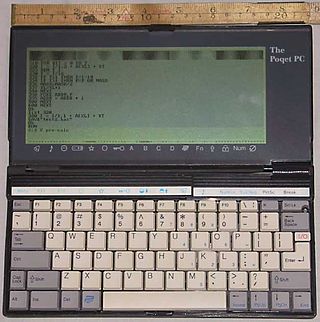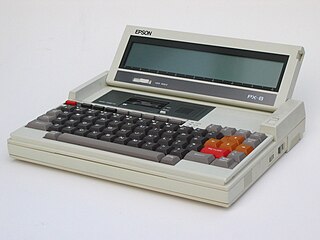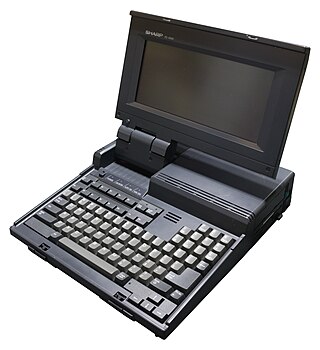Psion Organiser was the brand name of a range of pocket computers developed by the British company Psion in the 1980s. The Organiser I and Organiser II had a characteristic hard plastic sliding cover protecting a 6×6 keypad instead of a computer keyboard, with letters arranged alphabetically.

The Poqet PC is a very small, portable IBM PC compatible computer, introduced in 1989 by Poqet Computer Corporation with a price of $2000. The computer was discontinued after Fujitsu Ltd. bought Poqet Computer Corp. It was the first subnotebook form factor IBM PC compatible computer that ran MS-DOS. The Poqet PC is powered by two AA-size batteries. Through the use of aggressive power management, which includes stopping the CPU between keystrokes, the batteries are able to power the computer for anywhere between a couple of weeks and a couple of months, depending on usage. The computer also uses an "instant on" feature, such that after powering it down, it can be used again immediately without having to go through a full booting sequence. The Poqet PC is comparable to the HP 95LX/HP 100LX/HP 200LX and the Atari Portfolio handheld computers.

A touchpad or trackpad is a type of pointing device. Its largest component is a tactile sensor: an electronic device with a flat surface, that detects the motion and position of a user's fingers, and translates them to a position on a screen, to control a pointer in a graphical user interface. Touchpads are common on laptop computers, contrasted with desktop computers, where mice are more prevalent. Trackpads are sometimes used on desktops, where desk space is scarce. Because trackpads can be made small, they can be found on personal digital assistants (PDAs) and some portable media players. Wireless touchpads are also available, as detached accessories.

The Atari Portfolio is an IBM PC-compatible palmtop PC, released by Atari Corporation in June 1989. This makes it the world's first palmtop computer.

The TRS-80 Model 100 is a notebook-sized portable computer introduced in April 1983. It was the first commercially successful notebook computer, as well as one of the first notebook computers ever released. It features a keyboard and liquid-crystal display, in a battery-powered package roughly the size and shape of a notepad or large book. The 224-page, spiral-bound User Manual is nearly the same size as the computer itself.

The Psion Series 3 range of personal digital assistants were made by Psion PLC. The four main variants are the Psion Series 3 (1991), the Psion Series 3a (1993), the Psion Series 3c (1996), and the Psion Series 3mx (1998), all sized 165 by 85 by 22 millimetres. Further, a Psion Series 3a variant with factory installed software for the Russian language was called a Psion Series 3aR, and Acorn Computers sold renamed versions of the Psion Series 3 and 3a marketed as the Acorn Pocket Book and Acorn Pocket Book II.
The Psion Series 7 is a subnotebook computer from Psion that was released in 2000. In size it is fairly original: larger than a palmtop or handheld machine, but smaller than a laptop computer. It was the first and last of the Psion series to have a full color electronic visual display. It has a leather-bound clamshell design, with a touch-sensitive, Video Graphics Array (VGA) resolution liquid-crystal display (LCD) and QWERTY computer keyboard. Internally it has a 132.71 MHz StrongARM SA-1100 processor, 16 megabyte (MB) of random-access memory (RAM) and 16 MB of internal read-only memory (ROM).

The Psion netBook is a small subnotebook computer developed by Psion. Released in 1999, it was for the mobile enterprise market.

The Epson PX-8 a.k.a. Geneva was a small laptop computer made by the Epson Corporation in the mid-1980s.

The Gavilan SC is an early laptop computer first released by the Gavilan Computer Corporation in April 1984. The computer ran on an Intel 8088 microprocessor running at 5 MHz and sported a touchpad for a pointing device, one of the first computers to do so. The laptop was developed by Manuel "Manny" Fernandez, founder of the Gavilan Computer Corporation, and unveiled in May 1983.

The Compaq Presario 1200 was a line of notebook computers produced between 1998 and 2000 by Compaq as part of Compaq Presario line.

The UltraLite is a line of notebook-sized laptops first released by NEC in 1988. The original model was released in October 1988, alongside the heavier and more-capable ProSpeed. The UltraLite was the first notebook computer on the market compatible with the IBM PC. The original model was based on the NEC V30 microprocessor; the computer includes MS-DOS 3.3 built into ROM.

The history of laptops describes the efforts, begun in the 1970s, to build small, portable Personal Computers that combine the components, inputs, outputs and capabilities of a Desktop Computer in a small chassis.
The Dell Inspiron Mini Series is a line of subnotebook/netbook computers designed by Dell. The series was introduced in September 2008 amidst the growing popularity of low-cost netbook computers introduced by competitors.
The ICL DRS was a range of departmental computers from International Computers Limited (ICL). Standing originally for Distributed Resource System, the full name was later dropped in favour of the abbreviation.

The ThinkPad X series is a line of laptop computers and convertible tablets produced by Lenovo with less power than its other counterparts. It was initially produced by IBM until 2005.

The IdeaPad S Series is a series of notebook computers launched by Lenovo in October 2008. The IdeaPad S10 was initially scheduled for launch in September, but its release was delayed in the United States until October.

The Packard Bell Statesman was an economy line of notebook-sized laptops introduced in 1993 by Packard Bell. They were slower in performance and lacked features compared to most competitor products, but they were lower in price. It was created in a collaboration between Packard Bell and Zenith Data Systems. The Statesman series was essentially a rebrand of Zenith Data Systems Z-Star 433 series, with the only notable difference of the logo in the middle and text on the front bezel.
Armada is a discontinued line of business laptops by Compaq. They started as a more affordable version of the Contura line, but after that, they replaced Contura as a mainstream laptop line, and then the high-end Compaq LTE line were merged with Armada as a premium 7300 and 7700 sub-lines.

The Sharp PC-4500 is a line of laptop computers released by Sharp Corporation in 1987. The line comprises the PC-4501, the PC-4502, and the PC-4521. The PC-4501 is a bare-bones unit with only 256 KB of RAM stock, only one floppy drive, no backlighting, and no built-in numeric keypad; the PC-4502 and PC-4521 bumps the stock RAM to 640 KB and includes the latter two features while providing either two floppy drive (PC-4502) or one floppy drive and a 20 MB hard drive (PC-4521). Prices on the line initially ranged from $1,295 to just under $3,000; the PC-4501 was later sold for $995, becoming one of the first sub-$1,000 laptops available on the market. The PC-4500 line received mixed, mostly positive, reviews on its release in September 1987.
















